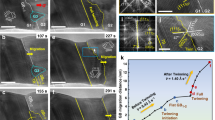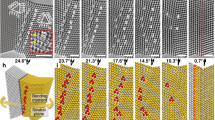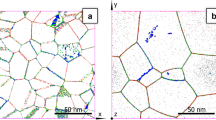Abstract
Molecular-dynamics simulations have recently been used to elucidate the transition with decreasing grain size from a dislocation-based to a grain-boundary-based deformation mechanism in nanocrystalline f.c.c. metals. This transition in the deformation mechanism results in a maximum yield strength at a grain size (the 'strongest size') that depends strongly on the stacking-fault energy, the elastic properties of the metal, and the magnitude of the applied stress. Here, by exploring the role of the stacking-fault energy in this crossover, we elucidate how the size of the extended dislocations nucleated from the grain boundaries affects the mechanical behaviour. Building on the fundamental physics of deformation as exposed by these simulations, we propose a two-dimensional stress-grain size deformation-mechanism map for the mechanical behaviour of nanocrystalline f.c.c. metals at low temperature. The map captures this transition in both the deformation mechanism and the related mechanical behaviour with decreasing grain size, as well as its dependence on the stacking-fault energy, the elastic properties of the material, and the applied stress level.
This is a preview of subscription content, access via your institution
Access options
Subscribe to this journal
Receive 12 print issues and online access
$259.00 per year
only $21.58 per issue
Buy this article
- Purchase on Springer Link
- Instant access to full article PDF
Prices may be subject to local taxes which are calculated during checkout



Similar content being viewed by others
References
Weertman, J. & Weertman, J.R. in Physical Metallurgy (ed. Cahn, J. W.) 921–1010 (North-Holland, Amsterdam, 1965).
Mukherjee, A.K., Bird, J.E. & Dorn, J.F. Experimental correlations for high-temperature creep. Trans. Am. Soc. Metals 62, 155–179 (1969).
Ashby, M.F. A first report on deformation-mechanism maps. Acta Metall. 20, 887–897 (1972).
Frost, H.J. & Ashby, M.F. Deformation-Mechanism Maps: The Plasticity and Creep of Metals and Ceramics (Pergamon, Oxford, 1982).
Mukherjee, A.K. An examination of the constitutive equation for elevated temperature plasticity. Mat. Sci. Eng. A 322, 1–22 (2002).
McFadden, S.X., Mishra, R.S., Valiev, R.Z., Zhilyaev, A.P. & Mukherjee, A.K. Low-temperature superplasticity in nanostructured nickel and metal alloys. Nature 398, 684–686 (1999).
Mukherjee, A.K., Mishra, R.S. & Bieler, T.R. Some critical aspects of high strain rate superplasticity. Mater. Sci. Forum 233–234, 217–234 (1997).
Higashi, K. & Mabuchi, M. Recent works in high strain rate superplasticity. Mater. Sci. Forum 233–234, 155 (1997).
Mishra, R.S., Valiev, R.Z., McFadden, S.X. & Mukherjee, A.K. Tensile superplasticity in a nanocrystalline nickel aluminide. Mater. Sci. Eng. 252, 174–178 (1998).
Mishra, R.S., McFadden, S.X., Valiev, R.Z. & Mukherjee, A.K. Deformation mechanisms and tensile superplasticity in nanocrystalline materials. J. Mater. Min. Soc. 51, 37–40 (1999).
Koch, C.C. & Suryanarayana, C. in Microstructure and Properties of Materials Vol. 2 (ed. Li, J.C.M.) 380–385 (World Scientific, Singapore, 2000).
Karch, J., Birringer, R. & Gleiter, H. Ceramics ductile at low-temperature. Nature 330, 556–558 (1987).
McFadden, S.X., Mishra, R.S., Valiev, R.Z., Zhilyaev, A.P. & Mukherjee, A.K. Low-temperature superplasticity in nanostructured nickel and metal alloys. Nature 398, 684–686 (1999).
Lu, L., Sui, M.L. & Lu, K. Superplastic extensibility of nanocrystalline copper at room temperature. Science 287, 1463–1466 (2000).
Kim, B.N., Hiraga, K., Morita, K. & Sakka, Y. A high-strain-rate superplastic ceramic. Nature 413, 288–291 (2001).
Nieh, T.G. & Wadsworth, J. Hall-Petch relation in nanocrystalline solids. Scripta Met. Mater. 25, 955–958 (1991).
Siegel, R.W. Mechanical properties of nanophase materials. Mater. Sci. Forum 235–238, 851–860 (1997).
Morris, D.G. & Morris, M.A. Hardness, strength, ductility and toughness of nanocrystalline materials. Mater. Sci. Forum 235–238, 861–872 (1997).
Yip, S. Nanocrystals — the strongest size. Nature 391, 532–533 (1998).
Yamakov, V., Wolf, D., Phillpot, S.R., Mukherjee, A.K. & Gleiter, H. Crossover in Hall–Petch behaviour in nanocrystalline materials by molecular-dynamics simulation. Phil. Mag. Lett. 83, 385–393 (2003).
Schiotz, J., DiTolla, F.D. & Jacobsen, K.W. Softening of nanocrystalline metals at very small grain sizes. Nature 391, 561–563 (1998).
Swygenhoven, H.V., Spaczer, M., Caro, A. & Farkas, D. Competing plastic deformation mechanisms in nanophase metals. Phys. Rev. B 60, 22–25 (1999).
Swygenhoven, H.V., Derlet, P.M. & Hasnaoui, A. Atomic mechanism for dislocation emission from nanosized grain boundaries. Phys. Rev. B 66, 024101 (2002).
Hirth, J.P. & Lothe, J. Theory of Dislocations 1st edn 306–353 (Wiley, New York, 1982).
Yamakov, V., Wolf, D., Phillpot S.R. & Gleiter, H. Grain-boundary diffusion creep in nanocrystalline palladium by molecular-dynamics simulation. Acta Mater. 50, 61–73 (2002).
Yamakov, V., Wolf, D., Salazar, M., Phillpot S.R. & Gleiter, H. Length-scale effects in the nucleation of extended lattice dislocations in nanocrystalline Al by molecular-dynamics simulation. Acta Mater. 49, 2713–2722 (2001).
Yamakov V., Wolf D., Phillpot S.R., Mukherjee A.K. & Gleiter H. Dislocation processes in the deformation of nanocrystalline aluminium by molecular-dynamics simulation. Nature Mater. 1, 45–48 (2002).
Cheng, S., Spencer, J.A. & Milligan, W.W. Strength and tension/compression asymmetry in nanocrystalline and ultrafine-grain metals. Acta Mater. 51, 4505–4518 (2003).
Li, J.C.M. Petch relation and grain boundary sources. Trans. Metall. Soc. AIME 227, 239–247 (1963).
Ercolessi, F. & Adams J.B. Interatomic potentials from 1st-principle calculations — the force-matching method. Europhys. Lett. 26, 583–588 (1994).
Bulatov, V.V., Richmond, O. & Glazo, M.V. An atomistic dislocation mechanism of pressure-dependent plastic flow in aluminum. Acta Mater. 47, 3507–3514 (1999).
Mukai, T. & Higashi, K. Ductility enhancement of ultra fine-grained aluminium under dynamic loading. Scripta Mater 44, 1493–1496 (2001).
Ogata, S., Li, J. & Yip, S. Ideal pure shear strength of aluminum and copper. Science 298, 807–811 (2002).
Wolf, D., Yamakov, V., Phillpot, S.R. & Mukherjee A.K. Deformation mechanism and inverse Hall-Petch behaviour in nanocrystalline materials. Z. Metallkd 94, 1091–1097 (2003).
Liao, X.Z. et al. A new deformation mechanism in nanocrystalline Al: partial dislocation slip. Appl. Phys. Lett. 83, 632–634 (2003).
Coble, R.L. A model for boundary diffusion controlled creep in polycrystalline materials. J. Appl. Phys. 34, 1679–1682 (1963).
Foiles, S.M. & Adams, J.B. Thermodynamic properties of fcc transition metals as calculated with the embedded-atom method. Phys. Rev. B 40, 5909–5915 (1989).
Dillamore, I.L. & Smallman, R.E. The stacking-fault energy of f.c.c. metals. Phil. Mag. 12, 191–193 (1965).
Parrinello, M. & Rahman, A. Polymorphic transitions in single crystals: A new molecular dynamics method. J. Appl. Phys. 52, 7182–7190 (1981).
Melchionna, S., Ciccotti, G. & Holian, B.L. Hoover NPT dynamics for systems varying in shape and size. Mol. Phys. 78, 533–544 (1993).
Clarke, A.S. & Jonsson, H. Structural changes accompanying densification of random hard-sphere packings. Phys. Rev. E 47, 3975–3984 (1993).
Acknowledgements
V.Y., D.W. and S.R.P. are supported by the US Department of Energy, BES-Materials Science under contract W-31-109-Eng-38. V.Y. is also grateful for support from the DOE/BES Computational Materials Science Network (CMSN). A.K.M. acknowledges support from NSF-DMR. We are grateful for grants of computer time on the Cray-T3E at the John-von-Neumann-Institute for Computing in Jülich, Germany, and on the Chiba City Linux cluster at Argonne National Laboratory.
Author information
Authors and Affiliations
Corresponding author
Ethics declarations
Competing interests
The authors declare no competing financial interests.
Rights and permissions
About this article
Cite this article
Yamakov, V., Wolf, D., Phillpot, S. et al. Deformation-mechanism map for nanocrystalline metals by molecular-dynamics simulation. Nature Mater 3, 43–47 (2004). https://doi.org/10.1038/nmat1035
Received:
Accepted:
Published:
Issue Date:
DOI: https://doi.org/10.1038/nmat1035
This article is cited by
-
Multi-field Coupled Inverse Hall–Petch Relations for Ferroelectric Nanocrystals
Acta Mechanica Solida Sinica (2024)
-
A Novel Metastable Structure in Polycrystalline Metals With Extremely Fine Grains: Schwarz Crystal
Metallurgical and Materials Transactions A (2024)
-
Dislocation loop bias and void swelling in irradiated α-iron from mesoscale and atomistic simulations
Communications Materials (2023)
-
Chemical inhomogeneity–induced profuse nanotwinning and phase transformation in AuCu nanowires
Nature Communications (2023)
-
Structural phase transformation in single-crystal Fe–Cr–Ni alloy during creep deformation using molecular dynamics simulation and regression-based machine learning methodology
Bulletin of Materials Science (2023)



